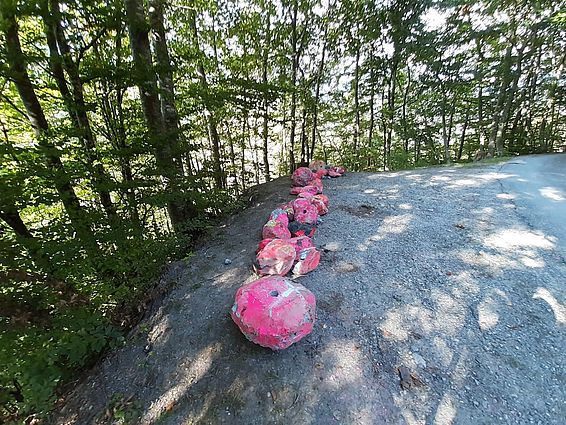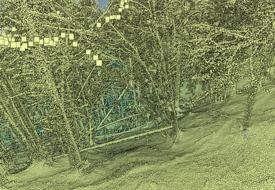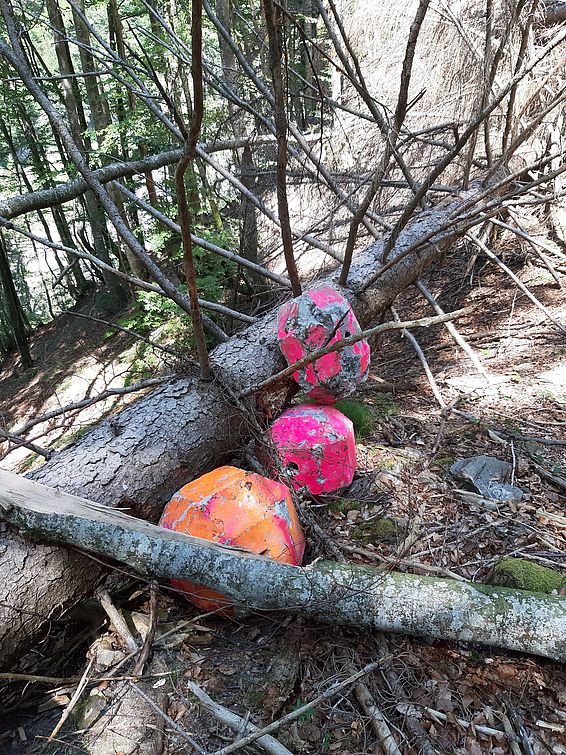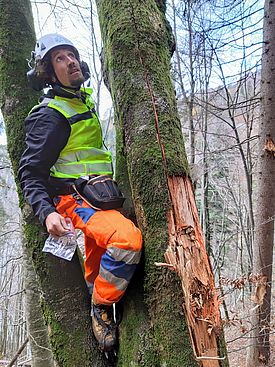Rolling stones in the name of science: SLF researchers are investigating how forests can best protect against rockfall and what effect dead wood has on this process.
As far back as the 14th century, forest clearance was prohibited in some areas as trees were known to protect against avalanches. However, forests also offer protection from rockfall, a hazard that is set to increase in the Alps as a result of climate change, along with other gravitational natural hazards such as avalanches, debris flow and rock slope failures.
High-tech rocks in steep terrain
"EOTA221, 200 kg. 3, 2, 1 - go!" SLF researcher Andrin Caviezel announces the shape and size of the rock before using his hands and feet to set it rolling. At a safe spot below, rockfall expert Adrian Ringenbach and his colleagues are waiting eagerly to see whether and how the rock will reach them. They then record the location where each rock comes to rest. Not all the rocks make it to the base of the slope, in which case the researchers have to scramble up the very steep terrain, which has an average gradient of 37°, with some sections exceeding 50°. "The measuring was a challenge in itself," explains PhD student Ringenbach, "but having two measuring teams made things more efficient."
The experiments in the Schraubachtobel in Schiers (canton of Grisons), at an altitude of 760 metres, used the same rocks as the rockfall experiments in the Flüela Pass. The concrete blocks, manufactured in the SLF workshop, contain sensors that measure the rocks' rotation speed and impact acceleration in high temporal resolution. These sensors, together with video footage captured by cameras installed on the slope, allow the trajectories of the rocks to be completely reconstructed.
Unlike with the Flüela Pass experiments, the surrounding forest meant that the view of the trajectory was very limited in the Schraubachtobel. As filming from the opposite slope was not possible, a total of 14 cameras were fitted along the 280-metre route, which recorded the rocks' whole trajectory from start to finish. Prior to the experiments, the entire slope along the fall path had been surveyed using high-resolution LiDAR (see film/photo). Approximately 200 rocks in total, ranging in size from 30 to 800 kg, were hurled down the slope over the course of 12 days, some with and some without sensors.
Barrier and tunnel effects
The experiments had two main objectives: firstly, to ascertain what impact the shape of the rock has on its trajectory and deposition area in forested terrain, and secondly to determine the effect of the forest structure, and of lying dead wood in particular. The fall path contained a number of tree trunks, mainly spruce, brought down by Storm Burglind (also known as Storm Eleanor) in January 2018.
To start with, six experiments were carried out in summer and autumn 2019 to measure the barrier effect of lying trees. The most effective were found to be those with a diameter of 30–59 cm. A tunnel effect was also observed: as some of the tree trunks were not lying completely flat on the ground, either because they were propped up by strong branches or because they had fallen over small depressions, smaller rocks were sometimes able to roll underneath them. This led to some unexpected results, with smaller rocks (45 kg) coming to a standstill further down the slope than medium-sized ones (200 kg).
Remarkable initial results
The dead wood was then airlifted off the slope in December 2019, allowing the first experiments without dead wood to take place in April 2020. These showed that wheel-shaped rocks travelled less far on average than their cube-shaped counterparts. This is a remarkable result given that the experiments conducted in the Flüela Plass have so far found exactly the opposite: the wheel-shaped rocks there have tended to have a longer run-out, and certainly a greater lateral spread. While a wheel-shaped rock also claimed the distance record in Schiers, the majority of the wheel-shaped rocks came to a halt in the upper reaches of the slope. "We are attributing this to the fact that, when the rock hits trees, it is knocked out of its wheel configuration. It then slides along the ground flat on its side, and is usually brought to a halt by the increased friction," says Ringenbach. By contrast, after cube-shaped rocks hit a tree, they carried on rolling, albeit at a slower speed.
As expected, dead wood and lifted root plates had a major impact, with significantly more rocks coming to rest behind lying trunks than standing ones. The results were particularly clear-cut with the cube-shaped 800-kg rocks: only four out of ten rocks reached the foot of the slope with the dead wood in place, compared with nine out of ten without. The outcome was somewhat less clear with smaller rocks. "We suspect that this is due to the slightly lower gradient and the fact that the ground where the trunks were cleared was still somewhat rougher even after the trunks had been removed. Several smaller rocks stopped in the area where the dead wood used to be, even when the lying trunks were no longer there," explains the 33-year-old PhD student.
The data collected will be used to calibrate the RAMMS software, which simulates avalanches, rockfall and debris flows. The research results provide valuable insights into where and how much dead wood should be left in a forest for maximum efficiency in terms of protection from rockfall and forest management.
The enormous jump height of a wheel-shaped rock. The reason for this is the high speed the rock reaches prior to jumping in the former dead-wood section. Video: A. Ringenbach, SLF
The reason why, on average, the wheel-shaped rocks have a shorter run-out: after colliding with a standing tree, the rock is thrown out of its wheel configuration. As it slides on the ground flat on its side, the friction is too great and the rock comes to a halt in the former dead-wood section. Video: A. Ringenbach, SLF
We would like to thank the Commune of Schiers for allowing us to use the forest for these experiments.
Contact
Links
Copyright
WSL and SLF provide the artwork for imaging of press articles relating to this media release for free. Transferring and saving the images in image databases and saving of images by third parties is not allowed.




